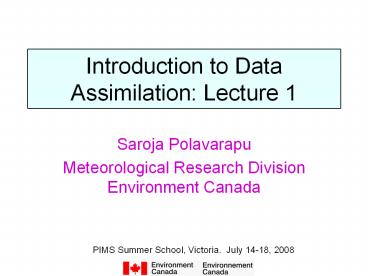Introduction to Data Assimilation: Lecture 1 - PowerPoint PPT Presentation
Title:
Introduction to Data Assimilation: Lecture 1
Description:
Introduction to Data Assimilation: Lecture 1. Saroja Polavarapu ... Radiosonde observations used. U,V,T,P,ES profiles at 27 levels. Pilot balloon observations used ... – PowerPoint PPT presentation
Number of Views:344
Avg rating:3.0/5.0
Title: Introduction to Data Assimilation: Lecture 1
1
Introduction to Data Assimilation Lecture 1
- Saroja Polavarapu
- Meteorological Research Division Environment
Canada
PIMS Summer School, Victoria. July 14-18, 2008
2
Goals of these lectures
- Basic idea of data assimilation (combining
measurements and models) - Basic processes of assimilation (interpolation
and filtering) - How a weather forecasting system works
- Some common schemes (OI, 3D, 4D-Var)
- Progress over the past few decades
- Assumptions, drawbacks of schemes
- Advantages and limitations of DA
3
Approach
- Cant avoid equations but there are only a few
(repeated many times) - Deriving equations is important to understanding
key assumptions - Introduce standard equations using common
notation in meteorological DA literature - Introduce concepts and terminology used by
assimilators (e.g. forward model, adjoint model,
tangent linear model) - Introduce topics using a historical timeline
4
Outline of lectures 1-2
- General idea
- Numerical weather prediction context
- Fundamental issues in atmospheric DA
- Simple examples of data assimilation
- Optimal Interpolation
- Covariance Modelling
- Initialization (Filtering of analyses)
- Basic estimation theory
- 3D-Variational Assimilation (3Dvar)
5
Atmospheric Data Analysis
- Goal To produce a regular, physically
consistent, four-dimensional representation
of the state of the atmosphere from a
heterogeneous array of in-situ and remote
instruments which sample imperfectly and
irregularly in space and time. (Daley, 1991)
analysis
6
- Approach Combine information from past
observations, brought forward in time by a model,
with information from new observations, using - statistical information on model and observation
errors - the physics captured in the model
- Observation errors
- Instrument, calibration, coding,
telecommunication errors - Model errors
- representativeness, numerical truncation,
incorrect or missing physical processes
Analysis Interpolation Filtering
7
Why do people do data assimilation?
- To obtain an initial state for launching NWP
forecasts - To make consistent estimates of the atmospheric
state for diagnostic studies. - reanalyses (eg. ERA-15, ERA-40, NCEP, etc.)
- For an increasingly wide range of applications
(e.g. atmospheric chemistry) - To challenge models with data and vice versa
- UKMO analyses during UARS (1991-5) period
8
Producing a Numerical Weather Forecast
- Observation
- Collect, receive, format and process the data
- quality control the data
- Analysis
- Use data to obtain a spatial representation of
the atmosphere - Initialization
- Filter noise from analysis
- Forecast
- Integrate initial state in time with full PE
model and parameterized physical processes
Data Assimilation
9
Data Assimilation Cycles
10
The Global Observing System
http//www.wmo.ch/web/www/OSY/GOS.html
11
Observations currently in use at CMC
Canadian Meteorological Centre Centre
Météorologique Canadien
Maps of data used in assimilation on July 1, 2008
12Z
12
Radiosonde observations used
U,V,T,P,ES profiles at 27 levels
13
Pilot balloon observations used
U,V profiles at 15 levels
14
Wind profiler obs used
U,V (speed, dir) profiles at 20 levels
15
SYNOP and SHIP obs used
U,V,T,P,ES at surface
16
Buoy observations used
U,V,T,P,ES at surface
17
Aircraft observations used
T,U,V single level (AIREP,ADS) or up to 18 levels
(BUFR,AMDAR)
18
Cloud motion wind obs used
U,V (speed, dir) cloud level
19
AMSU-A observations used
Brightness temperatures ch. 3-10
20
AMSU-B observations used
Brightness temperatures ch. 2-5
21
GOES radiances used
Brightness temperature 1 vis, 4 IR
22
Quikscat used
U,V surface
23
SSM/I observations used
Related to integrated water vapour, sfc wind
speed, cloud liquid water
24
Underdeterminacy
X state vector
Z observation vector
Data Reports x items x levels
Sondes,pibal 720x5x27
AMSU-A,B 14000x12
SM, ships, buoys 7000x5
aircraft 19000x3x18
GOES 5000x1
Scatterometer 7000x2
Sat. winds 21000x2
TOTAL 1.3x106
Model Lat x long x lev x variables
CMC global oper. 800x600x58x4 1x108
CMC meso-strato 800x600x80x4 1.5x108
- Cannot do Xf(Y), must do Yf(X)
- Problem is underdetermined, always will be
- Need more information prior knowledge, time
evolution, nonlinear coupling
25
Optimal Interpolation
N1
N1
M1
NM
MN
N1
Weight matrix
26
Analysis increments (xa xb) must lie in the
subspace spanned by the columns of B
Properties of B determine filtering properties of
assimilation scheme!
27
The fundamental issues in atmospheric data
assimilation
- Problem is under-determined not enough
observations to define the state - Forecast error covariances cannot be determined
from observations. They must be stat. modelled
using only a few parameters. - Forecast error covariances cannot be known
exactly yet analysis increments are composed of
linear combination of columns of this matrix - Very large scale problem. State O(108)
- Nonlinear chaotic dynamics
28
Simple examples of data assimilation
29
Analysis error Background error Observation error
30
(No Transcript)
31
(No Transcript)
32
(No Transcript)
33
(No Transcript)
34
(No Transcript)
35
(No Transcript)
36
(No Transcript)
37
(No Transcript)
38
Obs 1
analysis
Daley (1991)
39
(No Transcript)
40
representativeness
measurement
41
(No Transcript)
42
(No Transcript)
43
(No Transcript)
44
(No Transcript)
45
OI was the standard assimilation method at
weather centres from the early 1970s to the
early 1990s.
Canada was the first to implement a
multivariate OI scheme.
Gustafsson (1981)
46
Summary (Lecture 1)
- Data assimilation combines information of
observations and models and their errors to get a
best estimate of atmospheric state (or other
parameters) - The atmospheric DA problem is underdetermined.
There are far fewer observations than is needed
to define a model state. - Optimal Interpolation is a variance minimizing
scheme which combines obs with a background field
to obtain an analysis

